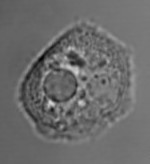Contractile vacuole facts for kids
A contractile vacuole (say "con-TRACK-tile VACK-you-ole"), often called a CV, is like a tiny pump found inside many cells, especially in single-celled organisms. Its main job is to collect extra water from inside the cell and then push it out. This helps the cell stay healthy by keeping the right amount of water inside, a process called osmoregulation.
Contents
What is a Contractile Vacuole?
A contractile vacuole is a special part of a cell, known as an organelle, that helps manage water. Think of it as a small, balloon-like sac that can expand and shrink. It's crucial for organisms that live in fresh water, where there's always a risk of too much water flowing into their cells.
Why Do Cells Need Them?
Cells need contractile vacuoles to deal with a process called osmosis. Osmosis is when water moves from an area where there's a lot of it to an area where there's less. If a cell lives in fresh water, there's more water outside the cell than inside. This means water will naturally try to rush into the cell. Without a way to get rid of this extra water, the cell would swell up and could even burst, like an overfilled balloon!
How Does a Contractile Vacuole Work?
The contractile vacuole works in a simple but clever two-step process:
- Filling phase: The vacuole slowly collects water from the cell's cytoplasm (the jelly-like substance inside the cell). It expands as it fills up.
- Emptying phase: Once the vacuole is full, it moves to the cell's surface and contracts (squeezes). This pushes the collected water out of the cell through a small pore. Then, it starts filling up again.
This continuous pumping action ensures the cell maintains a stable internal water balance, which is vital for its survival.
Where Are Contractile Vacuoles Found?
Contractile vacuoles are mostly found in:
- Protists: These are tiny, single-celled organisms like Paramecium and Amoeba. Since many protists live in fresh water, they rely heavily on contractile vacuoles to survive.
- Some Fungi: Certain types of fungi also have contractile vacuoles.
- Algae: Some freshwater algae use them too.
You won't find contractile vacuoles in animal cells because animal cells have different ways to manage their water balance, and they often live in environments where the water concentration is more balanced with their internal cells.
Importance of Contractile Vacuoles
The contractile vacuole is super important for the organisms that have it. Without this tiny pump, these cells wouldn't be able to control their water levels and would quickly be damaged or destroyed by too much water. It's a great example of how cells have amazing ways to adapt and survive in their environments!


